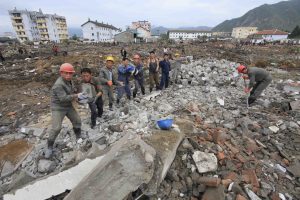North Korea is at a crossroads. Its already weak economy continues to suffer as a result of the ongoing pandemic even while natural disasters wreak havoc throughout the country. Severe rains and flooding over the past year have forced Pyongyang to take a stronger stance on climate change and adopt a range of environmental policies for the sake of the country’s future. Although a step in the right direction, it remains to be seen whether the North Korean government can live up to its promises of a greener future.
A Climate Emergency
In 2020 alone, four powerful typhoons battered North Korea in quick succession in the summer months, resulting in serious damage to homes, infrastructure, and agricultural land. North Korea’s Kangwon, North Hwanghae, South Hwanghae, North Pyongan, and South Pyongan provinces were particularly affected – three of which are considered the country’s breadbasket and provide more than half of the country’s rice and crop production.
In the aftermath of the typhoons, the North Korean government set out to better educate the public on how to prevent further damage as well as how to cope with similar climate emergencies. According to the Korea Central News Agency (KCNA), Workers’ Party officials conducted an “intensive information campaign” aimed at the public while implementing “immediate and thoroughgoing measures” to deal with the crisis.
The situation was taken seriously at the highest levels of government, with Supreme Leader Kim Jong Un going as far as to convene an enlarged meeting of the Executive Policy Council of the Central Committee of the Workers’ Party to organize a recovery campaign to address the impact of the natural disasters that hit South and North Hamgyong provinces. Kim visited the disaster-stricken areas in person, emphasizing the importance of studying the causes and impact of such climate-related crises while calling for increased “single-minded unity” for the recovery efforts.
The situation was dire indeed. The summer of 2020 saw the most rainfall many provinces had seen in four decades. According to the U.N.’s Food and Agriculture Organization (FAO), North Korea’s food shortages further increased in 2020 as a result of heavy flooding. As a result of the serious situation, the FAO added North Korea to its list of 45 countries requiring external assistance for food that year. Moreover, a South Korean report concluded that the North would grow only 80 percent of the 5.5 million tons of food it would need in 2020.
Besides a reduced crop yield, North Korea also suffered from serious infrastructure damage throughout the country as a result of the typhoons. Thousands of homes were believed to be destroyed, displacing countless people and leaving them homeless. One key issue, however, was the fact that many of the destroyed homes were actually newly-built only four years ago. This suggests that North Korea’s massively propagandized construction efforts over the past years were more for show than anything else.
































